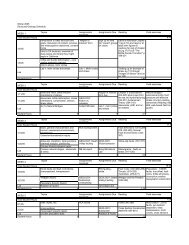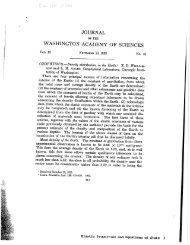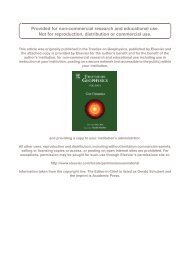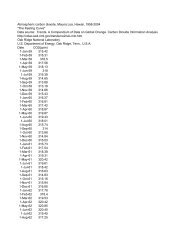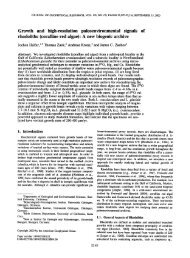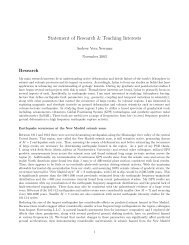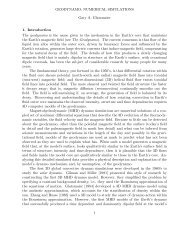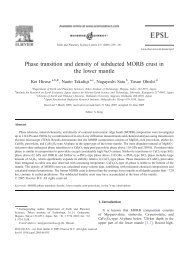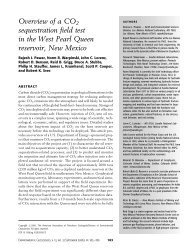From Greenhouse to Icehouse – The Eocene/Oligocene - UMass ...
From Greenhouse to Icehouse – The Eocene/Oligocene - UMass ...
From Greenhouse to Icehouse – The Eocene/Oligocene - UMass ...
You also want an ePaper? Increase the reach of your titles
YUMPU automatically turns print PDFs into web optimized ePapers that Google loves.
318 J. E. Francis et al.<br />
Author's personal copy<br />
by exceptionally high recovery (up <strong>to</strong> 98%). In the 702 m deep CIROS-1<br />
hole (Barrett, 1989; Barrett et al., 1991), the lower part of the core was<br />
originally regarded as Late <strong>Eocene</strong>, with a breccia passing up in<strong>to</strong> muds<strong>to</strong>ne<br />
and sands<strong>to</strong>ne. <strong>The</strong> boundary with the <strong>Oligocene</strong> was originally placed<br />
at about 570 m (Barrett et al., 1989), but magne<strong>to</strong>biostratigraphic data<br />
(Wilson et al., 1998a) suggest that the E/O boundary is much higher at about<br />
410<strong>–</strong>420 m. In either case, there is no obvious lithological transition, these<br />
finer grained facies including alternations of weakly stratified sand and mud,<br />
with intraformational conglomerate and occasional diamictite. <strong>The</strong>se facies<br />
are strongly bioturbated and contain exotic clasts, as well as intraclasts,<br />
while some beds are graded. Moving up core, a major hiatus exists at 366 m,<br />
which coincides with the Early/Late <strong>Oligocene</strong> boundary. Above is a suite of<br />
fining-upwards sands<strong>to</strong>ne beds, followed by alternating massive and<br />
stratified diamictites and thin interbeds of sand and mud (Hambrey et al.,<br />
1989).<br />
<strong>The</strong> CIROS-1 core was originally interpreted in terms of depositional<br />
setting, ice proximity and water depth (Hambrey et al., 1989; Hambrey &<br />
Barrett, 1993; Barrett, 1996). <strong>The</strong> breccia at the base of the hole is interpreted<br />
as a fault-brecciated conglomerate. <strong>The</strong> overlying sands<strong>to</strong>ne/muds<strong>to</strong>ne/<br />
diamictite succession is marine, influenced <strong>to</strong> varying degrees by resedimentation<br />
and iceberg-rafting. Above the Early/Late <strong>Oligocene</strong> hiatus, the<br />
sands<strong>to</strong>nes were regarded as fluvial, and the diamictites as basal glacial<br />
deposits, indicating ice overriding the site. However, Fielding et al. (1997)<br />
argued, based on a sequence stratigraphic analysis, that the Late <strong>Oligocene</strong><br />
diamictite was also glaciomarine. In contrast, Hiemstra (1999) reverted in<br />
part <strong>to</strong> the original view of grounded ice on the basis of microstructural<br />
studies. Whichever solution is the correct one, there is no clear evidence for a<br />
major environmental shift at the E/O boundary, but there is one <strong>to</strong>wards<br />
lower sea level at the Early/Late <strong>Oligocene</strong> transition.<br />
A record of climate change through the E/O transition has also been<br />
determined from the environmental magnetic record in the CIROS-1 core<br />
(Sagnotti et al., 1998). Variations in magnetite were related <strong>to</strong> the<br />
concentration of detrital material transported in<strong>to</strong> the Vic<strong>to</strong>ria Land Basin,<br />
influenced by climate and weathering rates on the Antarctic continent<br />
(especially of the Ferrar Group). Sagnotti et al. (1998) determined, from<br />
changes in the abundance of magnetite, that although there were some cold<br />
dry intervals (35<strong>–</strong>36 and W36.5 Ma) alternating with warm humid climates<br />
during the Late <strong>Eocene</strong>, a stable cold dry climate was not established in<br />
Antarctica until the E/O boundary, with major ice-sheet growth occurring at<br />
the Early/Late <strong>Oligocene</strong> boundary. This pattern matches clay mineral<br />
his<strong>to</strong>ry, which shows a shift from smectite-rich <strong>to</strong> smectite-poor assemblages





